Why E-Verify Background Checks Matter for Your Business
Many HR managers assume that e-verify background checks cover everything they need to know about new hires. The reality is very different, because E-Verify is not a background check at all.
Quick Answer: What Are E-Verify Background Checks?
- E-Verify checks work eligibility only (no criminal history)
- Traditional Background Checks review criminal records, employment history, and education
- You Need Both to satisfy compliance and protect workplace safety
- Timing Matters: run background checks after a conditional offer, complete E-Verify within three business days of hire
This confusion costs businesses time, money, and compliance headaches. One screening expert told us, “Many employers proudly display their E-Verify poster, and when asked about criminal background checks, point to the poster and say, ‘Yes, see, we E-Verify.’”
The truth is simple. E-Verify confirms your new hire can legally work in the United States. Traditional background checks tell you whether they should. Knowing the difference helps you avoid costly mistakes and build a reliable hiring process.
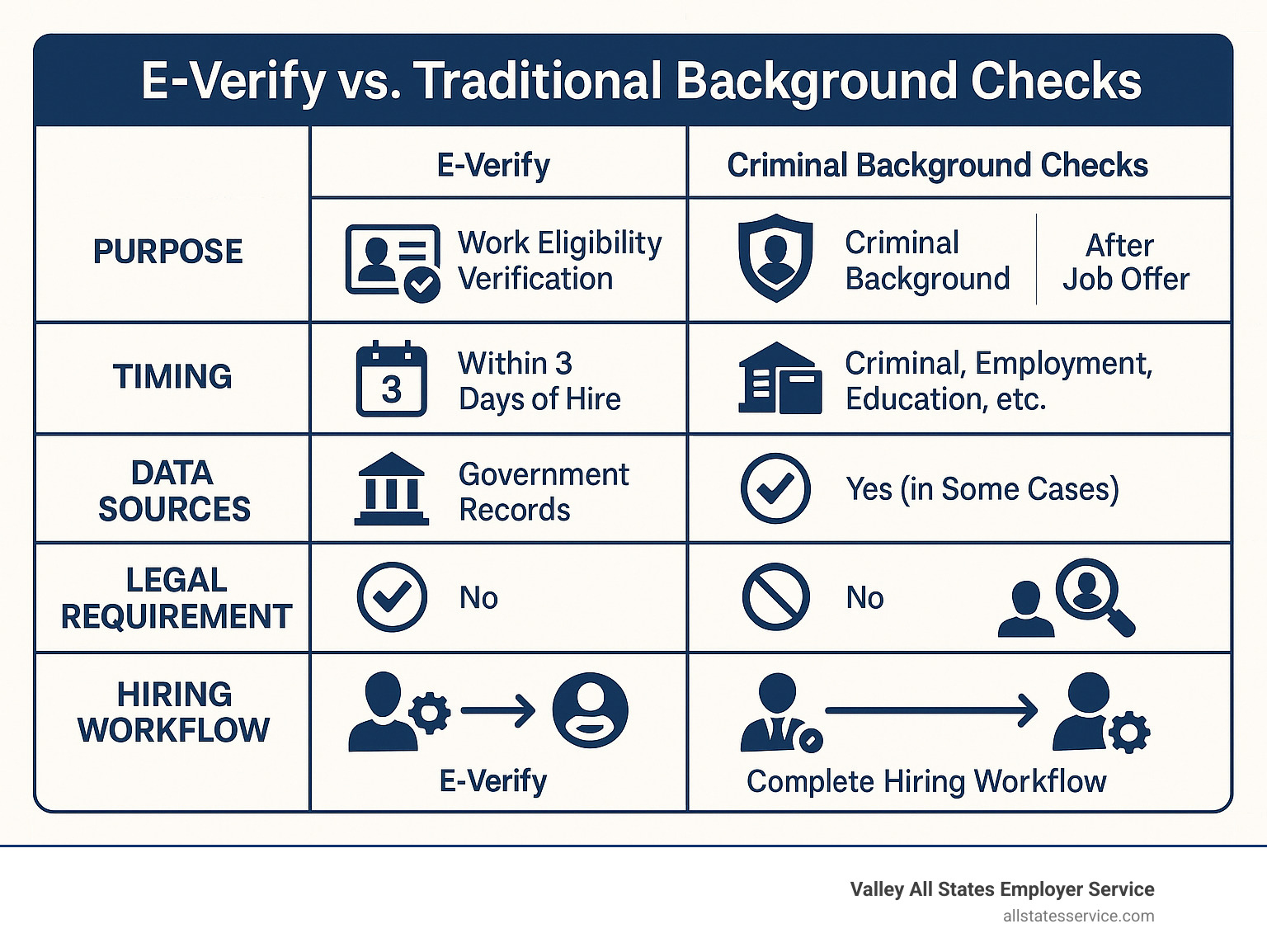
E-Verify vs. Traditional Background Checks
Here’s the truth that surprises most HR managers: E-Verify and background checks are completely different tools that serve totally different purposes. It’s like comparing a key to a security camera. Both help protect your business, but they work in entirely different ways.
E-Verify focuses on one thing only: work eligibility. This internet-based system, run by the Department of Homeland Security, takes your new hire’s Form I-9 information and compares it against government records from DHS and the Social Security Administration. It answers exactly one question: “Can this person legally work in the United States?”
Traditional background checks tell you about character and history. These comprehensive screenings dive into criminal records, employment history, education verification, credit reports, and driving records. They’re governed by the Fair Credit Reporting Act (FCRA) and require written consent from your candidate.
E-Verify verifies work authorization only and delivers results in 3-5 seconds using SSA and DHS databases. You must complete it within 3 business days of hire, and it’s completely free. Traditional background checks review criminal history, employment, and education but can take several days to complete using court records and employer references. These typically happen after a job offer but before the start date and involve costs for screening services.
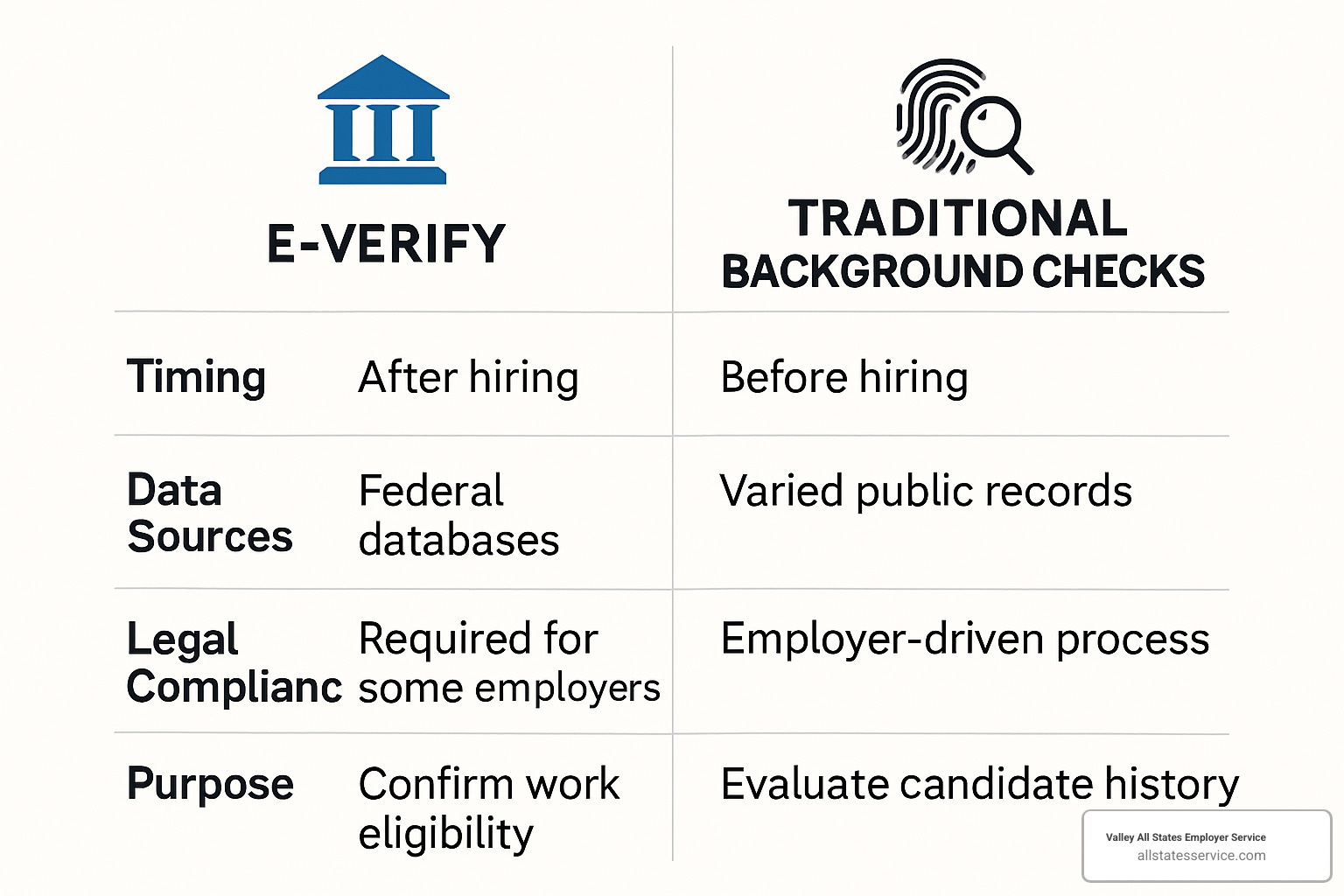
Why Two Checks, Not One
Smart employers use both systems because they protect against different risks. E-Verify keeps you compliant with federal law and helps you avoid penalties for hiring unauthorized workers. Background checks protect your workplace from potential safety and security issues that could lead to negligent hiring claims.
This compliance layering approach makes perfect sense. E-Verify handles the legal requirement for work eligibility verification. Background checks provide the due diligence you need on character and qualifications to protect your business and other employees.
For comprehensive screening that goes beyond basic eligibility, consider our Pre-Employment Work History Verification services alongside E-Verify to build a complete picture of your candidates.
Common Misconceptions
The biggest misconception we hear is “E-Verify equals a background check.” This assumption puts businesses at serious risk. E-Verify only confirms work eligibility. It won’t tell you if someone has a criminal record, lied on their resume, or has a history of workplace violence.
Another common mistake involves the E-Verify participation poster. Many employers point to their poster when asked about background checks, thinking it shows they screen for criminal history. That poster only means you verify work eligibility, nothing more.
Understanding these differences isn’t just about compliance. It’s about building a hiring process that actually protects your business while giving you confidence in your new hires.
How E-Verify Works Step-by-Step
Think of E-Verify as your digital compliance partner that works behind the scenes to confirm your new hires can legally work in the U.S. The process might seem complex at first, but it’s actually quite straightforward once you understand the flow.
Your journey begins with Form I-9, the same employment eligibility verification form you’ve always used. Every new hire completes this form regardless of whether you use E-Verify. Your employee fills out Section 1 on their first day, providing basic information and confirming their work authorization status.
Next comes document review and Section 2 completion. You examine your employee’s identity and work authorization documents from the acceptable document list. This step must happen within three business days of your employee’s start date. You complete Section 2 of the I-9, carefully recording all document information.
Here’s where E-Verify enters the picture. After completing the I-9, you log into the E-Verify system and create a case using your employee’s information. You’ll enter their name, date of birth, Social Security number, and citizenship status. The system also requires you to upload a recent photo of the employee.
The system works incredibly fast. E-Verify compares your information against DHS and SSA records and returns results within 3-5 seconds. You’ll receive either “Employment Authorized” or a “Tentative Nonconfirmation” (TNC).
Remember the three-day rule: you must submit e-verify background checks information within the first three business days of employment. Missing this deadline can result in compliance violations that nobody wants to deal with.
For detailed guidance on navigating the I-9 process smoothly, our I-9 Verification Assistance services can help you avoid common pitfalls.
You can also watch the E-Verify Overview webinar for a comprehensive walkthrough of the system.
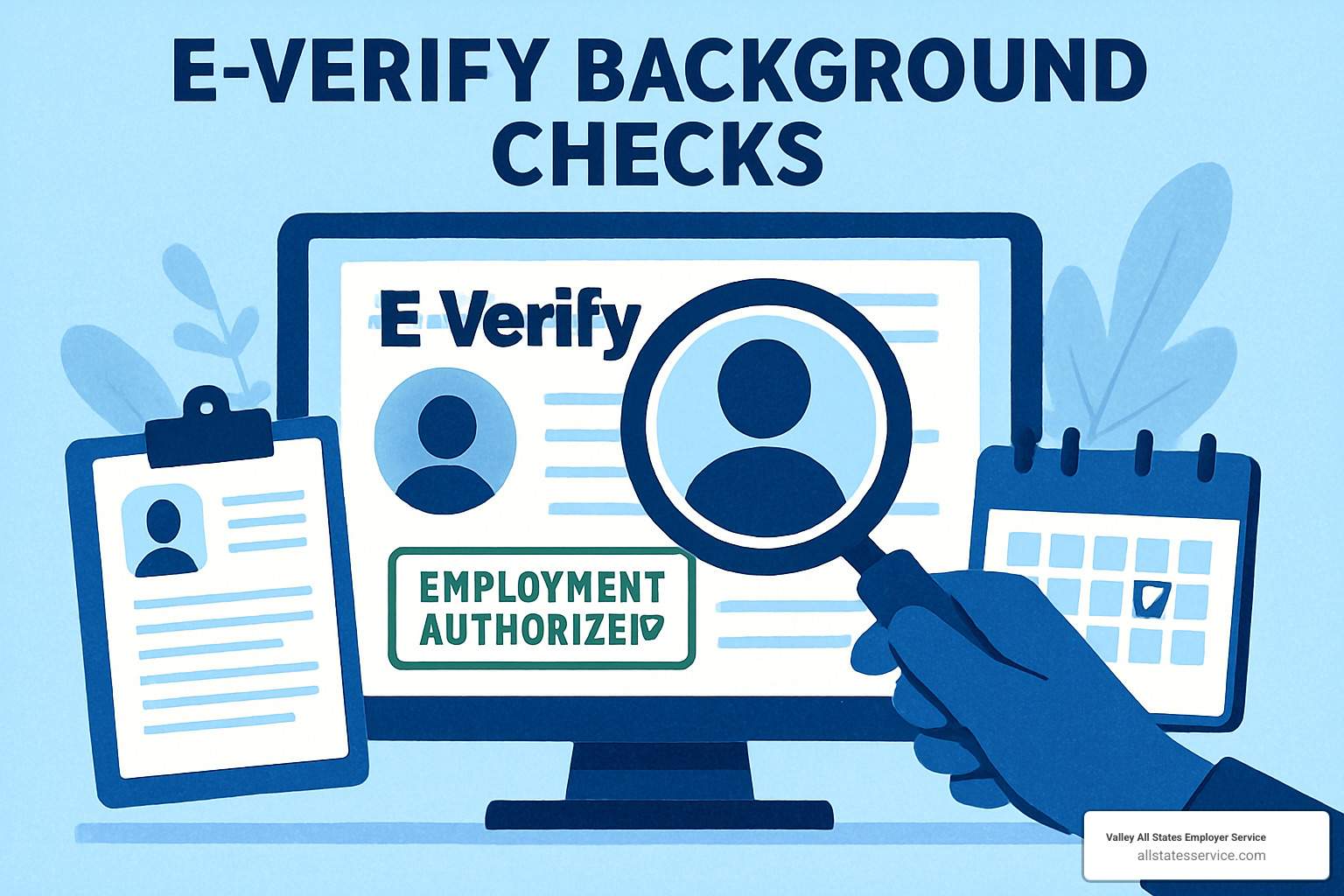
Creating a Case
Creating an E-Verify case is like building a digital profile of your new employee using information from their completed Form I-9. Accuracy is everything here because even small mistakes can trigger unnecessary complications.
From Section 1, you’ll need your employee’s core information: their full legal name exactly as it appears on their documents, date of birth, Social Security number, and citizenship or immigration status. Don’t forget the employee’s signature and date from this section.
Section 2 provides the document details that make E-Verify work. You’ll enter the document title from List A, or the combination of List B and C documents your employee provided. The system needs the document number, expiration date (if applicable), and issuing authority.
Here’s what trips up many employers: small data entry errors. A misspelled name, wrong date, or incorrect document number can trigger a Tentative Nonconfirmation that could have been avoided.
That’s exactly why many employers partner with our I-9 Verification Assistance services. We help minimize these errors through careful data entry and quality checks.
Tentative Nonconfirmation (TNC) Workflow
Don’t panic if you receive a Tentative Nonconfirmation. A TNC isn’t a dead end, it’s simply E-Verify’s way of saying there’s a mismatch between the information you entered and what’s in government records.
TNCs happen for surprisingly common reasons. Data entry errors top the list, like misspelled names or wrong dates. Name changes that haven’t been updated in government records cause many TNCs, especially for employees who recently married or divorced.
When you receive a TNC, your response matters legally. You cannot terminate or suspend the employee, period. Instead, you must provide them with the Further Action Notice, an official document explaining their rights and next steps. Your employee then has 8 federal government working days to contact the appropriate agency and resolve the issue.
Most TNCs get resolved successfully. The key is staying patient and following the process correctly.
Our E-Verify Best Practices guide covers exactly how to minimize TNCs and handle them properly when they do occur, keeping you compliant every step of the way.
When and Where E-Verify Is Required
Figuring out whether you need to use E-Verify can feel like navigating a maze. The requirements depend on who you are, where you’re located, and what kind of work you do.
Federal contractors have it simple – if you have any federal contract, you must use E-Verify. Period. The Federal Acquisition Regulation doesn’t care if your contract is worth $1,000 or $1 million. You’re in, and you need to verify all your employees, not just the ones working on federal projects.
State requirements are trickier. Some states jumped on the E-Verify bandwagon early and made it mandatory for everyone. Others have specific rules based on your company size or whether you work with the government. A few states haven’t mandated it at all, leaving the choice up to you.
Head-count triggers add another layer of complexity. Some states only require E-Verify once you hit a certain number of employees. Miss that threshold change, and you could find yourself non-compliant without realizing it.
Mandatory vs. Voluntary States
Arizona and Mississippi don’t mess around. Every employer in these states must use E-Verify, whether you’re a one-person shop or a Fortune 500 company. No exceptions, no excuses.
Federal contractor requirements cast a wide net. If you’re a federal contractor anywhere in the country, you’re required to use E-Verify for all employees. This includes subcontractors, and yes, it applies even if most of your work isn’t federal.
Other states have mixed approaches. Utah, Nebraska, and Missouri require government contractors to use E-Verify. Georgia, Colorado, and North Carolina have various requirements that kick in based on employee count or contract status.
Voluntary participation has its perks even when you’re not required to join. You get reduced liability during I-9 audits, better compliance confidence, and protection from knowingly hiring unauthorized workers.
Our Automated Eligibility Verification System helps you stay compliant regardless of your location or industry requirements.
Special Populations & Expiring Docs
Recent policy changes have created new challenges for employers dealing with certain groups of workers. Staying current with these updates isn’t optional – it’s essential for compliance.
TPS Venezuela beneficiaries got good news. Their work authorization extends through April 2, 2026. When you’re creating E-Verify cases, use the extended date, not whatever’s printed on their original EAD.
Afghan parolees present a unique situation. Those with Form I-94 showing class of admission ‘PAR’ can work based on their parole status. They can present their I-94 as a List A receipt, but here’s the catch – you must reverify them within 90 days of hire.
The 540-day auto-extension rule creates another wrinkle. Some TPS beneficiaries who filed renewal applications before October 26, 2023, get automatic 540-day extensions of their EADs. You must accept expired EADs if they come with valid Form I-797C receipts.
Document tracking becomes critical with all these special cases. You need detailed records of document expiration dates and reverification requirements. Missing a reverification deadline can result in compliance violations, even if the employee is authorized to work.
Benefits and Limitations of E-Verify Background Checks
Understanding what e-verify background checks can and cannot do helps you use the system effectively and avoid compliance gaps.
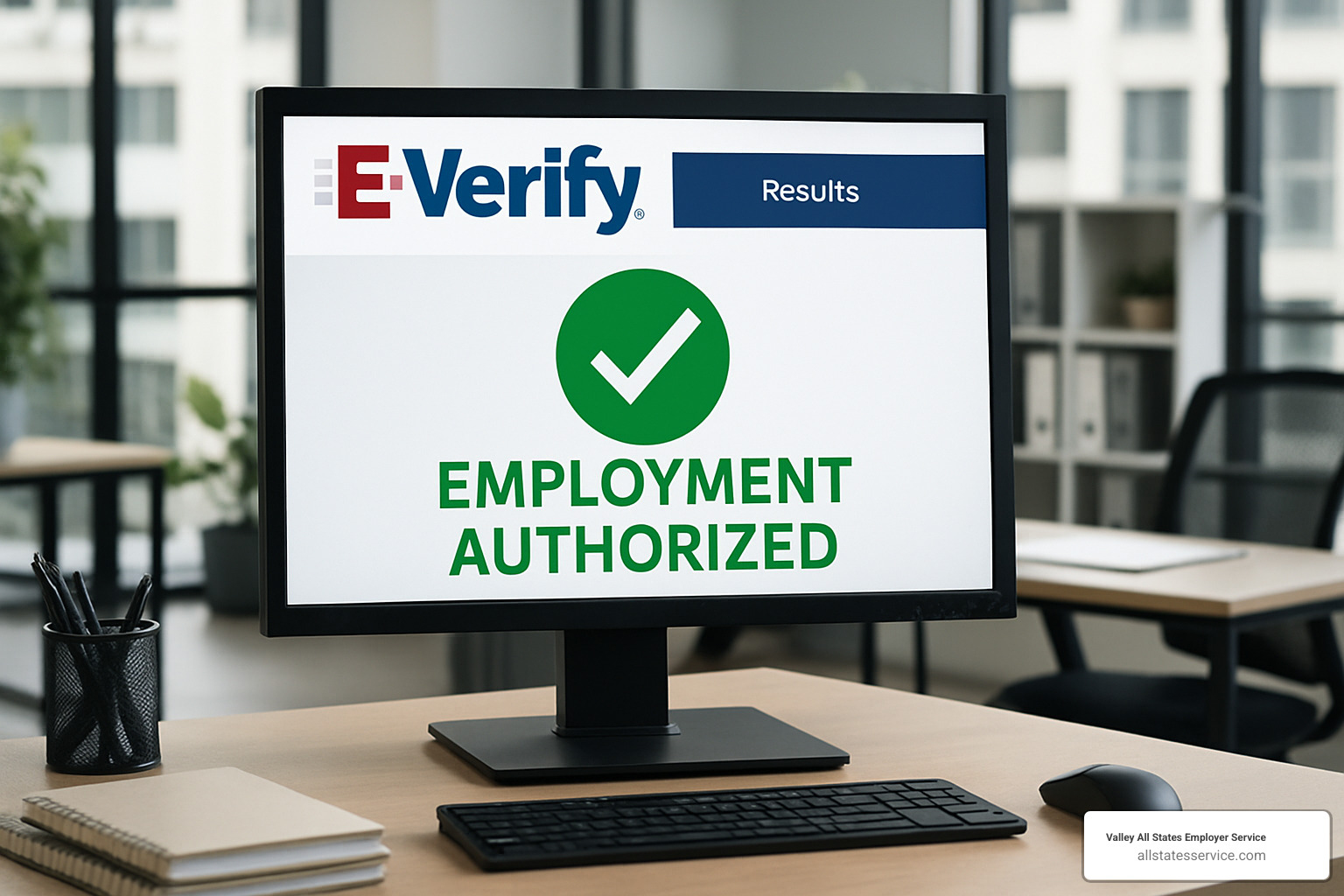
Advantages of E-Verify Background Checks
The beauty of E-Verify lies in its instant results. Within 3-5 seconds, you know whether your new hire is eligible to work. Compare that to traditional background checks that can take days or weeks, and you’ll see why so many employers appreciate the speed.
Cost is never a concern with E-Verify because the government provides it free of charge. Unlike traditional background screening services that charge per check, E-Verify costs nothing regardless of how many employees you verify. This makes it accessible whether you’re a small business hiring your first employee or a large corporation onboarding hundreds.
Using E-Verify creates reduced compliance risk by demonstrating good faith effort to verify work eligibility. If immigration authorities find you’ve hired unauthorized workers, your participation in E-Verify can significantly reduce penalties. It shows you’re making a genuine effort to follow the law.
The deterrent effect shouldn’t be underestimated. When job seekers see your E-Verify participation poster, those who aren’t authorized to work often don’t bother applying. This saves you time screening candidates who couldn’t legally work anyway.
For businesses with remote workers, E-Verify offers a remote I-9 option that allows document examination from a distance. This flexibility has become increasingly valuable as more companies accept remote work arrangements.
Brand trust matters more than ever, and E-Verify participation signals to customers, partners, and stakeholders that you operate legally and responsibly. Government database access through E-Verify means you’re checking against millions of authoritative records from DHS and SSA.
Our E-Verify Services help you maximize these benefits while maintaining full compliance with all requirements.
Limitations of E-Verify Background Checks
Here’s where many employers get tripped up: E-Verify contains no criminal history data. An employee could have a violent criminal record and still receive “Employment Authorized” status if they’re legally eligible to work. This is why smart employers never rely on E-Verify alone.
The limited scope means E-Verify only answers one question: “Can this person legally work?” It won’t tell you about education credentials, employment history, professional licenses, or any other qualifications that matter for job performance.
Database errors in government systems can create headaches for legitimate workers. We’ve seen employees receive Tentative Nonconfirmations because their married name wasn’t updated in Social Security records, or because of simple data entry mistakes in government databases.
E-Verify’s single-use policy means you can only run it once per employee, even if you rehire them later (unless their work authorization expired). You also cannot pre-screen job applicants, which means you can’t use E-Verify to filter candidates before making job offers.
Anti-discrimination requirements demand that you apply E-Verify uniformly to all new hires or none at all. You can’t selectively verify only certain employees based on appearance, accent, or national origin. This protects workers but limits your flexibility.
False negatives occur when authorized workers receive TNCs due to data mismatches, creating administrative burden and potential delays in the hiring process. The system provides no character assessment whatsoever, telling you nothing about work ethic, honesty, or reliability.
For the latest information on E-Verify capabilities and limitations, visit the official E-Verify website.
Integrating E-Verify with Comprehensive Screening
The smartest hiring approach combines e-verify background checks with traditional screening at exactly the right moments. Think of it like building a house – you need both a strong foundation and quality materials, but each comes at its proper time in the construction process.
Here’s how the best-practice timeline works: Start with your usual application and interview process to identify top candidates. Once you’re ready to make a hiring decision, extend a conditional job offer and immediately begin traditional background checks. This timing protects you legally under FCRA rules while giving you the information you need before the employee starts work.
After your new hire begins work, complete Form I-9 on their first day and submit their E-Verify case within three business days. This sequence ensures you’re checking character and qualifications before commitment, then verifying work eligibility after hire but within the required timeframe.
Modern HRIS systems make this integration seamless. Look for platforms that automatically track background check progress, send E-Verify deadline reminders, store I-9 forms electronically, and flag upcoming reverification dates.
Outsourcing Options
Working with designated employer agents can transform your E-Verify experience from a compliance chore into a smooth, automated process. The government allows these agents to handle E-Verify processing using their own accounts, which means less work for your HR team and fewer opportunities for costly mistakes.
Smart-form technology makes a huge difference in reducing the technical errors that trigger unnecessary TNCs. These electronic I-9 systems validate your data entry in real-time, catch common formatting mistakes before they become problems, and ensure all required fields are completed correctly.
The best agents offer comprehensive support that goes far beyond portal access. They provide error review and correction, compliance training, audit support, and integration with your existing systems. Our Employer HR Compliance services include all of these elements because we’ve learned that partial solutions create partial results.
Building a Compliant Workflow
Policy uniformity isn’t just good practice – it’s the law. Once you decide to use E-Verify, you must apply it to every new hire, not just selected employees. Choosing to verify only certain workers based on appearance, accent, or national origin constitutes discrimination and can result in serious penalties.
Your audit trail tells the story of your compliance efforts. Keep detailed records of E-Verify case confirmations, TNC notices and resolutions, Further Action Notices provided to employees, reverification dates, and training records for your HR staff.
Record retention rules are specific and non-negotiable. Maintain E-Verify case confirmations until three years after hire or one year after termination, whichever is later. Keep TNC and Final Nonconfirmation records for three years after case closure. I-9 forms must be retained for three years after hire or one year after termination, whichever is later.
Staff training prevents most compliance problems before they start. Make sure your HR team understands proper I-9 completion procedures, E-Verify submission requirements and deadlines, TNC handling and employee rights, anti-discrimination requirements, and document acceptance rules.
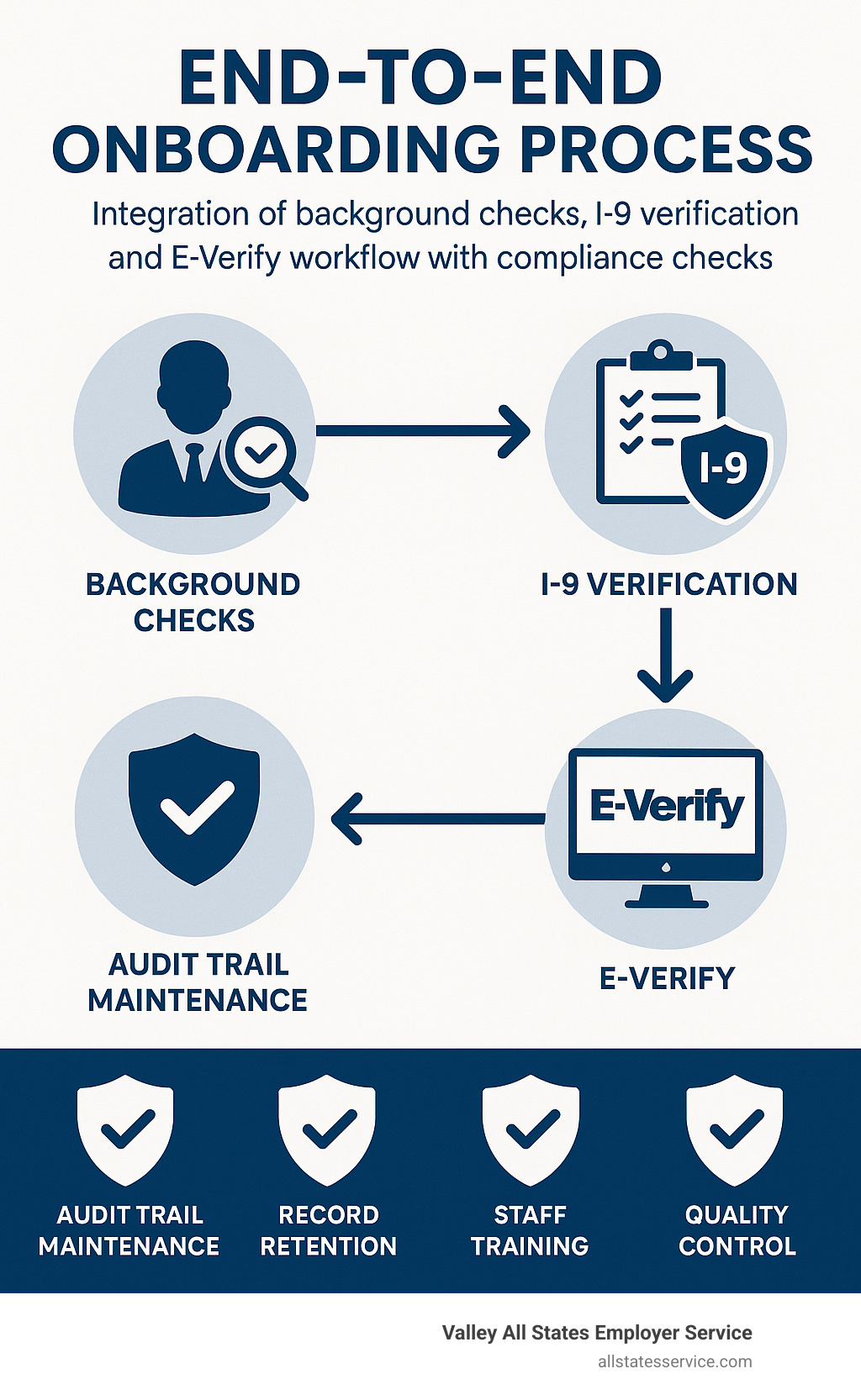
Building a compliant workflow takes effort upfront, but it saves countless hours and headaches down the road. The employers who struggle with E-Verify compliance are usually those who tried to shortcut the setup process.
Frequently Asked Questions about E-Verify Eligibility
What happens if E-Verify cannot confirm eligibility?
When E-Verify can’t immediately confirm your employee’s eligibility, you’ll receive what’s called a Tentative Nonconfirmation (TNC). Don’t panic, this doesn’t automatically mean your employee can’t work.
The most important rule: don’t take any adverse action against your employee. You cannot terminate, suspend, reduce hours, or take any negative action. This is where many employers get into trouble.
Instead, you must provide the Further Action Notice to your employee. This official document explains their rights and gives them clear steps to resolve the issue. Your employee then has 8 federal government working days to contact either DHS or SSA, depending on what type of mismatch occurred.
During the resolution process, your employee continues working normally while they sort things out with the government agency. Most TNCs happen because of simple data entry errors or outdated government records, not because someone is actually unauthorized to work.
Can I run E-Verify on existing staff?
This question comes up constantly, and the short answer is usually no. E-Verify is specifically designed for new hires, not for checking up on your current workforce.
However, there are three specific situations where you can use E-Verify on existing employees. First, during reverification when an employee’s work authorization expires. Second, if you receive a federal contract that requires E-Verify, you may need to verify existing employees assigned to that contract work. Third, when rehiring former employees after more than three years, or if their previous work authorization has expired.
The key principle here is consistency and fairness. You cannot selectively verify certain employees based on their appearance, accent, or national origin. That’s discrimination, and it can land you in serious legal trouble.
How quickly will I see results?
One of the biggest advantages of e-verify background checks is speed. Most cases receive “Employment Authorized” status within 3-5 seconds. Yes, you read that right, seconds, not minutes or hours.
Tentative Nonconfirmations also appear just as quickly, usually within that same 3-5 second window. However, if your employee needs to resolve a TNC, that process can take 8-10 federal government working days if they choose to contest the mismatch.
The E-Verify system runs 24/7 except during scheduled maintenance periods. Whether you submit cases during business hours or overnight, the system typically processes them immediately.
While E-Verify gives you instant results on work eligibility, traditional background checks for criminal history and other screening factors typically take 2-5 business days. The speed difference is why smart employers use both systems at the right times in their hiring process.
Conclusion
You’ve learned the most important truth about e-verify background checks: they’re not the same thing at all. E-Verify confirms work eligibility in seconds, while background checks reveal the character and history details that take days to uncover.
The bottom line is simple. E-Verify tells you if someone can legally work in the United States. Background checks tell you if they should work for your company. Smart employers use both tools because each one protects against different risks.
Getting the timing right makes all the difference. Run background checks after you make job offers but before employees start work. Complete E-Verify within three days of hire. This sequence keeps you compliant with both FCRA rules and federal employment eligibility requirements.
Your compliance requirements depend on your specific situation. Federal contractors must use E-Verify for everyone. Some states require it for all employers. Others have different rules based on your employee count or contract status.
Professional support transforms this process from a headache into a competitive advantage. Managing E-Verify compliance, handling TNCs properly, and integrating everything with background checks requires expertise. When you work with experienced professionals, you maximize the benefits while minimizing the risks and administrative burden.

Ready to build a complete screening process that combines E-Verify with comprehensive background checks? Our team specializes in helping employers steer these requirements while reducing administrative burden and ensuring compliance confidence.
Contact us today to learn how we can streamline your hiring process and give you peace of mind with every new hire. Visit our E-Verify Services page to get started.